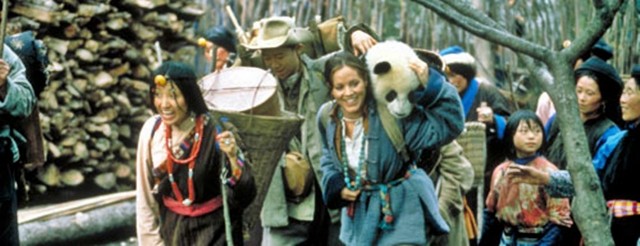
By Jae-Ha Kim
Chicago Sun-Times
September 14, 2001
![]()
“China: The Panda Adventure” won’t tell you anything about the giant panda that a Discovery Channel special doesn’t do better. But what the IMAX picture can do is present the magnificent beauty of China and its gorgeous giant pandas on a 6-story, 80-foot screen.
The visuals are stunning. From the opening shot of the Great Wall of China, to the lush foliage of the bamboo forests, to the intimate peek at the pandas at play, the cinematography is first rate.
Unfortunately, the story is plodding and simple-minded. The filmmakers underestimated the appeal of the giant pandas and shortchanged the stars of this 50-minute piece. Instead, the plot focuses on the real-life story of Ruth Harkness–a New York socialite who traveled to Shanghai in 1936 to collect the ashes of her late husband, who died while studying China’s giant panda population.
After encountering his nemesis–a cold-hearted hunter who’s eager to get his hands on her husband’s panda maps–she decides to finish the expedition herself and see firsthand whether the animals are as gentle as her husband had promised, or the ferocious beasts that game hunters claimed.
“You’re a silly, sentimental woman,” the hunter tells her.
He’s not too far off in describing the celluloid Harkness, portrayed by Maria Bello of “Coyote Ugly” fame. While the real-life Harkness was a pioneer in her own right, bringing the first living giant panda to the Brookfield Zoo in 1937, the on-screen version is a woman whose childish competitiveness leads her entire expedition into trouble.
Plot aside, Bello is a likable actress who does what she can with this after-school special-like script. When a fortune teller informs her that she’s come to China to have a baby, she looks puzzled. But the moviegoers all know what this means: She will be bringing home a baby panda.
We learn very little about the giant panda until the end credits, when a narrator doles out some interesting facts.
Giant pandas have been on Earth for more than three million years. But since the 1970s, the available panda habitat has shrunk by 50 percent. They are only found in the wild in China, and there are only about 1,000 giant pandas living in China, with another 100 in captivity.
Since females usually have twins, four litters might produce eight babies. The film errs in showing a female panda with her twin cubs in the wild. I learned on a Discovery Channel special that female pandas are peculiar in that they will raise only one of their young. Unless the babies are born in captivity–where a human can care for the other twin–one of the twins will die. This is also noted in the film’s press kit, but there’s no mention of it in the film.
In her autobiographical book, The Lady and the Panda, Harkness wrote, “I wondered why, of all people, I, who had quietly been designing clothes in New York, should have been selected by the gods of chance to be the first to bring a live Giant Panda to civilization.”
The film doesn’t really answer that. Or how she was able to persuade the Chinese government to allow her to bring the panda to the United States. Su Lin, the panda cub brought to the Brookfield Zoo, died a year after leaving China.
Still, the panda is the single most popular attraction in American zoos. It would’ve been nice if we could have seen more of them in this film.





